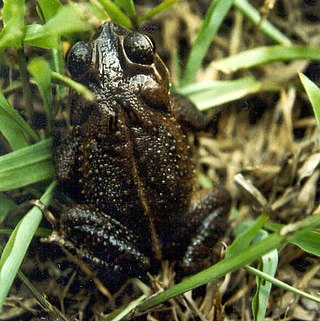
Leptobrachium hasseltii is a species of toad found in Southeast Asia. This frog named after Dutch Naturalist Johan Conrad van Hasselt. According to the current understanding, this species is known with certainty only from Java, Madura, Bali, and Kangean Islands, Indonesia. The species is also commonly reported to occur in the Philippines, but these are believed to refer to another, unnamed species.

Incilius campbelli is a species of toad in the family Bufonidae. It was first described in 1994. It is found in eastern Chiapas (Mexico), Guatemala, western Honduras, and Maya Mountains, Belize. Its natural habitats are lowland moist and premontane wet forests, and pristine forests in mountainous regions. It is threatened by habitat loss.
The bony-headed toad is a species of toad in the family Bufonidae. It is found in Cambodia, Laos, and Vietnam. Earlier it has been also reported from Hainan Island (China), but these have now been named as a new species, Ingerophrynus ledongensis. Its natural habitats are subtropical or tropical moist lowland forests, subtropical or tropical moist montane forests, and rivers. It is threatened by habitat loss.
Leptobrachium banae is a species of amphibian in the family Megophryidae. It is found in Laos, Vietnam, and possibly Cambodia. Its type locality is Ko Rong village, Gia Lai Province, Vietnam.
Leptobrachium buchardi is a species of amphibian in the family Megophryidae. It is endemic to Laos and only known from the Bolaven Plateau in the Champasak Province, near its type locality within the Dong Hua Sao National Protected Area. Its natural habitat is subtropical or tropical moist montane forests. It is threatened by habitat loss.

Leptobrachium chapaense is a species of amphibian in the family Megophryidae. It is found in China, Laos, Thailand, Vietnam, and possibly Myanmar. Its natural habitats are subtropical or tropical moist lowland forests, subtropical or tropical moist montane forests, and rivers. It is threatened by habitat loss.

Leptobrachium gunungense is a species of amphibian in the family Megophryidae. It is endemic to Malaysia. Its natural habitats are subtropical or tropical moist montane forests and rivers.
Leptobrachium hainanense, the Hainan pseudomoustache toad, is a species of amphibian in the family Megophryidae. It is endemic to the mountains of central and southwestern Hainan Island, China. Before being recognized as a separate species, it was confused with Leptobrachium hasseltii.

Leptobrachium hendricksoni is a species of amphibian in the family Megophryidae. It is found in Malay Peninsula, Sarawak (Borneo), and Sumatra (Indonesia). Its natural habitats are tropical moist lowland forests, rivers, freshwater marshes, and nearby plantations and heavily degraded former forests. It is threatened by habitat loss.
Leptobrachium nigrops, also known as the black-eyed litter frog, is a species of amphibian in the family Megophryidae. It is found in Indonesia, Malaysia, and Singapore. Its natural habitats are subtropical or tropical moist lowland forests, subtropical or tropical swamps, and rivers. It is threatened by habitat loss.
Oreolalax lichuanensis is a species of amphibian in the family Megophryidae. It is endemic to China, and found in south-central parts of the country . Its natural habitats are subtropical or tropical moist montane forests, subtropical or tropical moist shrubland, and rivers. It is threatened by habitat loss.
Oreolalax multipunctatus is a species of amphibian in the family Megophryidae. It is endemic to the Mount Emei region in Emeishan and Hongya counties of Sichuan, China. Its natural habitats are subtropical moist montane forests and rivers. It is threatened by habitat loss.
Oreolalax omeimontis is a species of amphibian in the family Megophryidae. It is endemic to Sichuan, China where it is found in Mount Emei and in Hongya County. Its natural habitats are subtropical moist montane forests and rivers. It is threatened by habitat loss.
Oreolalax pingii is a species of amphibian in the family Megophryidae. It is endemic to south-western China where it is restricted to the Daliang and Hengduan Mountains in Sichuan and Yunnan. Its natural habitats are subtropical moist montane forests, moist shrubland, and rivers. It is threatened by habitat loss.
Oreolalax popei is a species of amphibian in the family Megophryidae. It is endemic to China where it is found in southern Gansu, southern Shaanxi, and central and northeastern Sichuan provinces. Its natural habitats are temperate forests, subtropical moist lowland forests, moist montane forests, and rivers. It is threatened by habitat loss.
Leptobrachium ailaonicum is a species of amphibian in the family Megophryidae. It is found in Yunnan in southern China and on Fansipan mountain in northern Vietnam. Its type locality is Xujiaba in the Ailao Mountains in Jingdong County, Yunnan. At the time of the IUCN assessment in 2004, the population on Fansipan was considered a separate species, Leptobrachium (Vibrissaphora) echinatum, and assessed to be an endangered species.

Leptobrachium boringii, commonly known as the Emei moustache toad or Taosze spiny toad, is a species of amphibian in the family Megophryidae. It is endemic to China where it is found in Sichuan, Guizhou, and Hunan provinces. "Emei" or "Taosze" in its common names refer to its type locality, Taosze on Mount Emei, Sichuan. Its natural habitats are temperate forests, grassland, arable land, and rural gardens near rivers. It is threatened by habitat loss.
Leptobrachium liui, the Chong'an moustache toad or Pope's spiny toad, is a species of frog in the family Megophryidae.

Xenophrys aceras, commonly known as the Perak horned toad, Perak spadefoot toad or Malayan horned frog, is a species of frog in the family Megophryidae found in Peninsular Malaysia and Thailand, and possibly in Indonesia. Its common name refers to its type locality, Bukit Besar in Perak state, Malaysia.
The Medog horned toad, or Medog spadefoot toad, is a species of frog in the family Megophryidae. It was described as a subspecies of Omei horned toad based on specimens collected from Mêdog County, Tibet (China); it is still only known from its type locality. It probably has a wider distribution that may reach India. Its natural habitats are subtropical or tropical moist lowland forests, subtropical or tropical moist montane forests, and rivers.







